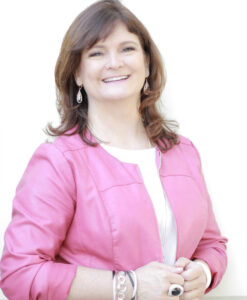For America’s most successful business owners—those earning well into the seven or eight figures—the financial rewards are obvious. But behind the wealth often lies an unsettling reality: they’re still bleeding money to taxes. And not just a little. In many cases, they’re handing over 45%, 48%, even 51% of their income to the IRS.
It’s a phenomenon that CPA and tax strategist Angie Grainger consider the “Success Penalty.” “You work hard, you build something great, and suddenly you’re punished for winning,” she says. “The tragedy? In many cases, this penalty is completely optional.”

Angie Grainger, CPA/PFS, CFP®, is not your average accountant. As a Certified Public Accountant with a Master’s in Taxation, a Personal Financial Specialist (PFS) designation, and a Certified Financial Planner™ (CFP®) certification, she operates as a Family Office Director, providing strategic oversight for the personal and business finances of high-net-worth entrepreneurs. Through her firm and personal brand, she has quietly become the go-to expert for those ready to stop overpaying and start playing the tax game to win. Her campaign slogan, “What’s Really Going On,” challenges conventional assumptions and exposes the blind spots in even the most sophisticated financial plans.
The Tax Illusion: Why Filing Isn’t Planning
Many successful entrepreneurs assume they’re getting top-tier tax advice simply because they have a seasoned CPA or a recognizable firm filing their returns. But as Grainger emphasizes, filing taxes is not the same as planning taxes.
By the time the return is prepared, the chance to save has passed. “The U.S. tax code is over 70,000 pages long—it’s not designed to be efficient,” she notes. “It’s designed to reward those who know how to use it.”
The financial strategist often meets clients who are operating with a reactive model. They run their businesses proactively—monitoring KPIs, hiring strategically, forecasting cash flow. But personally? Their finances are handled in silos. One advisor manages investments, another handles insurance, and another files the taxes. The result is missed opportunities and massive overpayments…and no one captaining the ship.
Bringing the Family Office Model to Entrepreneurs
That’s where Grainger’s role as a Family Office Director comes in. Traditionally reserved for ultra-high-net-worth families, the family office model integrates accounting, tax, investment, legal, estate, and insurance planning into one coordinated system.
“What we’re doing is giving 7- and 8-figure earners the billionaire treatment,” she says. “Because when you reach a certain income level, piecemeal advice is no longer enough. You need a unified financial strategy.”
Her firm serves as the quarterback, coordinating every aspect of the client’s financial life with proactive oversight. “We’re not just plugging numbers into a tax software. We’re looking across the entire financial ecosystem—where the money’s coming in, how it’s being used, and what future risks exist.”
And when her team gains that visibility? That’s when the “money found” moments happen.

“Money Found” Stories: Real Clients, Real Savings
Grainger’s website is filled with case studies of clients who discovered just how much they were missing once someone started asking the right questions.
Case Study #1: The Over-Taxed CEO
A business owner earning $1.2 million annually came to the expert with a 48% effective tax rate. Through restructuring income, optimizing entity-level taxes, and implementing a defined benefit plan, her team reduced his tax bill by 17%—saving him $204,000 annually, or over $2 million over the next decade.
Case Study #2: The Founder’s Exit
In preparing for an exit from his well-established practice, Grainger strategized with her team to creatively structure his sale to eliminate the upfront tax and put more cash in his pocket now. Her team implemented a deferred tax sale, cleaned up the accounting, restructured the entities and made over $15 million available to reinvest in new ventures right now. The result? A $7 million tax deferral and savings with long-term tax reduction for his estate.
Case Study #3: Real Estate, Real Mistakes
A couple with over $30 million in rental real estate thought their property management company was doing things well, but when Grainger’s team cleaned up the accounting, restructured the entities, and captured missed deductions, they not only increased their income by $80,000, but they also reduced their taxes by several hundred thousand.
Each case had a common thread: fragmented advice had cost these clients dearly. The strategist’s full-spectrum oversight changed the game.
The Three Tax Buckets: Where Others Get it Wrong
Life insurance sales people often talk about the Three Tax Buckets model— a simple but to understand where their money sits and how it’s taxed.
- Taxable Bucket
This includes savings accounts, brokerage accounts, and anything generating 1099 income. It’s taxed every year—without fail—and provides little room for strategic control. - Tax-Deferred Bucket
Think traditional 401(k)s and IRAs. You get a deduction now, but you’re building a future tax bomb—especially when Required Minimum Distributions (RMDs) begin. - Tax-Free Bucket
Roth IRAs, life insurance retirement plans, and other vehicles that allow money to grow and be withdrawn tax-free.
However, since many of these have limitations that don’t apply to the successful business owner, while other more advanced wealth building strategies, get missed. Grainger focuses on setting up advanced defined benefit strategies that not only allow up to $300,000 per year into retirement accounts, but also gets the banks and the IRS to pay for the life insurance to keep the cash available for vacations or other investments.
These hidden strategies are missed by insurance agents and investment advisors because they don’t have the comprehensive training of a CPA/PFS with the Family Office Director point of view.

The Roth Conversion – Is the Opportunity Going Away
Business owners in the highest tax brackets don’t like to pay taxes to convert a traditional IRA into a Roth IRA. It uses advanced tax planning and ‘what-if scenarios’ to carefully time the conversions. At year-end planning, these decisions get fine-tuned across all the business entities and investments to determine whether to convert to a Roth. In the Family Office Model, Grainger deals with multiple entities and family members that are affected by the income and investments that roll through to the individual person. Each person has their own situation that requires planning and decisions at year-end.
However, with the recent passing of the Big Beautiful Bill, Roth conversions require more precision planning with the recent changes in deductions, limitations and tax rates.
Annuities – Tax Strategy or Peace of Mind Strategy
Another frequently misunderstood tool is the annuity. While often maligned, annuities can serve a critical purpose when structured within the right tax bucket. Annuities can be placed within a Roth IRA for tax-free income, however most successful business owners face limitations in traditional retirement accounts and don’t have the funds inside the IRA or Roth IRAs to get the amount of annuities they need within those accounts.
But let’s not miss the point of what the family is trying to accomplish. Yes, saving taxes is a primary goal, however the real purpose of Family Office planning is to create peace of mind. Having confidence that the family will be taken care of later in life is a higher priority than taxes and utilizing annuities to create stable future income is a reliable strategy.
Grainger’s philosophy is “behind every business is a person…and that person is trying to accomplish something meaningful in life”. The priority is getting the family goals defined so that all tax, restructuring, investments and insurance strategies align to the goals. “First are the goals, then the strategies to fund the goals with the least amount of taxes, the most return, and as little risk as possible.”
Control Is the Ultimate Currency
At the heart of Grainger’s message is a challenge to take back control. Most business owners spend years optimizing operations, hiring the right team, and scaling revenue, but treat their personal finances like an afterthought.
“It’s not your fault,” she says. “The system is built to be complex. But once you see what’s really going on, and get someone in your corner who can map a path through it, you stop feeling like a victim of taxes. You become the architect of your own wealth.”
The biggest takeaway? If your current financial team isn’t coordinating across tax, investment, legal, and business structures, you’re almost certainly overpaying. And you deserve better.
Final Thought: The Wealth You Don’t See
True wealth isn’t just about how much you earn. It’s about how much you keep—and how efficiently that money grows and protects your future. Grainger’s work proves that the gap between “doing okay” and “thriving” often comes down to one thing: clarity.
By spotlighting what’s really going on in your financial life—whether through tax-efficient income strategies, oversight of your full financial picture, or smart restructuring—this financial advocate is helping America’s top entrepreneurs reclaim their power. The IRS may have written the code. But as Grainger reminds her clients, you get to choose how you play the game.
About Angie
Learn more at angie.cpa.
We don’t just report the news, we deliver it through the voices of multiple expert staff writers, each selected to broaden our scope and deepen our storytelling.



